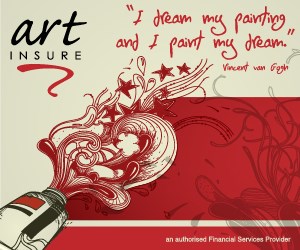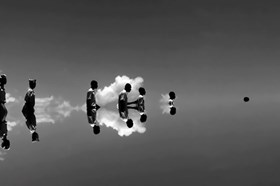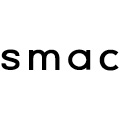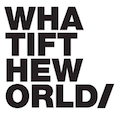artthrob artbio
Paul Edmunds
By Michael Smith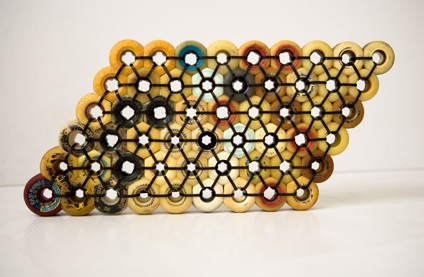
Paul Edmunds
Foam,
2009.
skateboard wheels and cable ties
24 x 50 x 4 cm.
This article is updated from Sean O’Toole's 2004 ARTBIO on Edmunds. It contains passages from his original text.
Paul Edmunds’s work has played a subtle yet strong role in the development of South African sculpture over the last 15 years. This subtlety is borne of an understanding of labour as much as form, with Edmunds pouring literally thousands of hours into his works. Yet he seems to resist flashy displays of effort, instead choosing discipline, repetition, and incremental detail as cornerstones of his approach.
art events calendar
VIEW FULL CALENDARbuy art prints
edition of 25: R3,500.00
About Editions for ArtThrob
Outstanding prints by top South African artists. Your chance to purchase SA art at affordable prices.
FIND OUT MORE Editions for artthrobMODUS OPERANDI
Edmunds’s output for most of his career has consisted of sculptures and prints, with the latter still fulfilling his own brief of being ‘physical objects’. At the heart of his sculptures is a quiet program of reclamation, through which the mundane, the incidental, and the cast-off become matter for art. Styrofoam cups and punnets, wire, data cables and sheets of wood veneer have all found new uses as base units from which Edmunds’s quietly complex works are made.
More recently, with his show ‘Subtropicalia’ at Michael Stevenson, Edmunds has utilized more used objects and materials as his starting point, relics of a surf/skate culture similar to the sort he remembers from his youth. Yet underpinning Edmunds’s references to subcultures and the divergent logics of these is an almost monastically disciplined employment of calculation, what writer Nic Dawes poetically calls ‘mute mathematics’.
Writing about Edmunds’s work in ArtThrob’s 2004 ARTBIO, Sean O’Toole gathered one of the most telling quotes by the artist about his own thought process behind creating such avowedly physical works: ‘Everyone says we live in the information age but I challenge you to walk into a wall while you are living in the information age. It is still going to hurt. We live in a world of objects and volumes and spaces.’
Repetition is a cornerstone of Edmunds’s methodology: base units are assembled according to marginally shifting patterns of interaction. Physical and conceptual layers accrue, yet the effect differs from that of Warholian repetition with its comments on consumer society. Instead of the aesthetic of fashionable exhaustion peddled by Pop art, Edmunds’s obsessive use of identical base units often serves to invite contemplation on the individual unit. The slow poetry of his sculptures and prints seems to sustain consideration while avoiding overload.
Tracy Murinik once observed in an earlier edition of ArtThrob, ‘Pieces that might initially appear unassuming ultimately astonish in their skill, their physicality and their quiet but reverberating aesthetic and overwhelming discipline. And yet there is also a lighter flipside to all this formal process in that the raw materials that Edmunds uses border on the quirky, being almost flippant’.
ARTIST'S STATEMENT
‘My work is characterised by an unconventional use of materials and cumulative processes as well as an ongoing exploration of pattern. On the cusp between abstraction and representation, my work seems more concerned with process than depiction.’
‘My work… tends to be received with an emphasis on its abstract properties. With 'Subtropicalia', using my story as a template through which to view the work, I track how memory, sensory phenomena and abiding interests inform my exploration of materials, forms, repetitive processes and design.’
CURRENTLY
Paul Edmunds is currently exhibiting ‘Subtropicalia’ at Michael Stevenson in Cape Town, until the end of November.
The exhibition reveals Edmunds’s use of personal narrative as a starting point for works that retain an interest in slow release, quietness, sustained concentration and incremental meaning.
The show began with a short story Edmunds had written a few years earlier about his childhood experiences growing up in Johannesburg, and his enduring preoccupation with skateboarding and surfing. He reflects on his separation from the sea, stuck inland, and the strange, unfulfilled nature of the desire to surf. This elusive fulfillment suggested became for Edmunds metaphoric of other levels of separation and disjuncture, as he noted in a statement about the show: ‘In some sense you are not really present for your experience, and that experience, anyway, is often characterised by a slight dissatisfaction – perhaps you can’t pull off a move the way you want, your wheels are too slow, the conditions in your life are unlike those in a magazine, and, regrettably, you live 600km from the coast.’
Foam from ‘Subtropicalia’, an upright trapezium of worn skateboard wheels, held together by uncharacteristically rough cable ties, speaks of his stalled motion and a certain sense of frustration as a result. The detail that usually accrues through the layers in Edmunds’s work occurs here on the ridden surfaces of the wheels, etched in through use over time. The compression of time into a single experience links back to previous works, but operates somehow differently here, less the product of labour and more the result of effort chasing the oft-elusive perfect ride.
Another work, Period, made from a material similar to that used to form bodyboards, is an arresting work, arguably more violent than many of Edmunds’s images, yet it retains the subtleties of shift and increment that are key to his practice. As Michael Stevenson’s website states, the almost carboniferous black forms of the suspended sculpture, their tough surfaces a foil for their elegantly-cut forms, ‘create structures that embody a series of growing and contracting waves’. Yet their ominous tonality and appearance make this work about as far from Zen-lite musings on abstract energy as one could get, and suggest an undeniably emotional content.
BEFORE THAT
Edmunds ended 2003 with a solo exhibition at João Ferreira Fine Art. Titled 'Cloud', the show presented a body of work that included his first foray into video, as well as a number of works made in his typical labour-intensive, crafted fashion. Critic Andrew Lamprecht described it as a ‘truly transporting exhibition’, further stating: ‘Not long after the opening I was flying to Johannesburg over an endless field of candyfloss clouds, so brilliantly lit that the view hurt my eyes. Edmunds came to mind: his singular white plastic construction, with its potential to invoke the infinite and the endless repetition of Sponge, with its possibility of losing oneself in one's own blanket of dreams.’
Earlier in 2003, Edmunds completed a large, outdoor sculpture at the Arabella-Sheraton Hotel on Cape Town's foreshore. The work clearly evidences the artist's interest in pattern and, in this reviewer's mind, is not dissimilar in form to the lattices used for guiding the growth of creepers and bougainvilleas. Executed in a striking monotone - red - the work is an understated piece of public architecture, one that is seemingly unencumbered by any desire to convey an obvious meaning, comfortable in being quietly unobtrusive.
Also in 2003, the Warren Siebrits Modern and Contemporary exhibited The same but different, a huge linocut printed in red. Somewhat reminiscent of graphic designer Peter Saville's spare cover design for the Joy Division album 'Unknown Pleasures', this work (originally exhibited in Edmunds's solo show 'Houding') was noteworthy for its elegant minimalism. Comprising one line that the artist took for a long, uninterrupted walk across the surface of the 180 x 95cm paper, Siebrits characterised the piece as an ‘an outstanding South African contemporary graphic’. An artist's proof of this linocut can be seen in the Dimension Data collection, in Johannesburg.
AND BEFORE THAT
Prior to his two group appearances in 2002, Edmunds held a one-person show at João Ferreira. Titled 'Houding', an Afrikaans word meaning attitude, or slang meaning 'wear-and-tear', the show presented only five works: three small bronzes, the aforementioned linocut, and an installation work titled Reef. Commenting on this latter work, an undulating line of stacked polystyrene cups, lightly glued together, with intricate arrows cut in each cup, Chris Roper described it as a ‘masterpiece of time poised, a beautiful moment captured just before it crashes and destroys itself.’
In his review of 'Houding', Roper casually mentioned Alan Alborough, a sculptor who also re-invents and recycles everyday objects. It is probably dangerous to draw too many comparisons between these two artists simply because of their usage of everyday consumer objects, but it is certainly true that both artists imbue their creations with meanings that have little or nothing to do with either the form or the function of the found object from which their works borrow life.
Roper best articulated this when he said: ‘To take something as disposable, as fragile, as the tray your mushrooms come in and then to render that thing solid, to give it a heft associated with weight and an authority associated with being an art object, that is already a notable feat’.
AND EVEN BEFORE THAT
During the two years leading up to the millennium, Edmunds exhibited twice at the now defunct Mark Coetzee Fine Art Cabinet. These shows were pivotal in establishing Edmunds as an emerging talent. For his show entitled 'Once, Again', Edmunds exhibited hundreds of small plastic cable ties and bottle tops that had been meticulously joined and pinned to form a latticed maze. Made out of materials found on the streets of Cape Town, Tracey Murinik characterised the work as a painstaking and largely obsessive project.’
Her insights into this work, published in the Mail & Guardian, merit revisiting. ‘Edmunds describes a concern with process in his work, referring at once to the process by which the work is made, and to a recognition of natural processes of which both he and the materials that he manipulates are a part,’ Murinik wrote. ‘The cyclical origins of the plastic he uses, in which one is able to plot an evolution of minerals and plant materials, to the fossil fuels which make up the plastic, for example, reflect the idea that all materials are in a constant state of change.’
Murinik further observed: ‘The visual forms which this work takes on echo this potential. The patterns and rhythms happen gradually in small, quiet movements. They grow in accumulated effect, evoking both an awareness of sameness and a recognition of variation. One becomes aware of the need to see greater, recognisable images in the maze - barely conscious attempts to find appeasing confirmation of oneself in the system.’
His work Scale, constructed from 10 000 cable ties removed from poles in the streets of Cape Town, was also exhibited at Mark Coetzee, in 1999, and currently forms part of the Dimension Data collection. Michael Stevenson, writing in his book Moving in Time and Space, remarked of this work: ‘The time-consuming process of collecting the ties, and painstakingly weaving them into a sculptural form ensures that its assembly is an extended meditative act of countless repetitive actions.
NEXT UP
Michael Stevenson will be taking some of Edmunds’s work to Art Basel Miami Beach late in 2009.
CURRICULUM VITAE
Paul Edmunds, born in 1970, in Johannesburg, is an artist based in Cape Town. He worked as a contributing editor and copy editor for www.artthrob.co.za for 11 years, and during that time also wrote regularly for Sculpture magazine, Flash Art and the Mail & Guardian. He has served as a judge in various art competitions, including the regional selection of the ABSA l'Atelier Award. Edmunds has taught at Craft Academy, an NGO based in Mauritius. He has lectured in Sculpture at the University of Stellenbosch, and lectured in Graphic Arts and served as a technician in Industrial Design at the Cape Technikon. He has also run a number of Creative Thinking workshops at Cape Town's AAA school.
EDUCATION
Edmunds completed a BA(FA) in 1991 and a MA(FA), with distinction, in 1995, both at the University of Natal, Pietermaritzburg.
SELECTED EXHIBITIONS
2003: 'Cloud', one-person exhibition at João Ferreira Fine Art, Cape Town, November 2; 'Prints and Multiples' Warren Siebrits Modern & Contemporary, Johannesburg, February
2002: Silence/ Violence, project curated by Greg Streak, culminating in simultaneous exhibitions in Durban and Nieubethesda with seven other South African and international artists, July; 'Bodies II: Sublimation', curated by Kathryn Smith, Klein Karoo Nasionale Kunstefees, Oudtshoorn, April
2001: One-person exhibition, 'Houding', at João Ferreira Fine Art, Cape Town, November 2000: 'Cast', exhibition of work in bronze, Bronze Age Foundry, Cape Town, December; 'Images of Self', curated by Clive van den Berg, Klein Karoo Nasionale Kunstefees, Oudtshoorn, March; 'Unplugged V', Market Theatre Gallery, Johannesburg, February
1999: One-person exhibition, 'Scale', The Mark Coetzee Fine Art Cabinet, Cape Town, October
1998: 'Family Ties', exhibition curated by Ricky Burnett and Penny Siopis, Sandton Civic Art Gallery, Johannesburg, December; Exhibition of Cape Town artists, Canberra Institute of Art, Canberra, Australia; One-person exhibition, 'Once, again', The Mark Coetzee Fine Art Cabinet, Cape Town, April
1997: One-person exhibition, 'Water', The Space Below the Lounge, Cape Town, March
1996: 'FNB Vita Art Now', Johannesburg, May; 'Jabulisa: The Art of KwaZulu-Natal', Pietermaritzburg, Durban, Grahamstown and Johannesburg; One-person exhibition, 'Stones, Leaves, Water', Phemba Kahle Centre, Pietermaritzburg, January
1995: Joint exhibition with Justin AnschŸtz, The Thompson Gallery, Johannesburg, April; 'Objects of Desire', exhibition of 11 KwaZulu-Natal artists, The Thompson Gallery, Johannesburg, March
1994: One-person exhibition, NSA Gallery, Durban, April
1993: Residence at the Cité Internationale des Arts, Paris, January - December
1992: Winner of 'Volkskas Atelier Award'
PUBLIC COLLECTIONS
As well as in various private collections, Edmunds' work is held in the following public collections: The Tatham Art Gallery, Pietermaritzburg; The Durban Art Gallery; The Carnegie Art Gallery, Newcastle; The Empangeni Art and Cultural History Museum; The KwaZulu-Natal Museum Services collection, Sasol Art collection, BHP Billiton collection, Dimension Data collection and The New Museum, New York.
COMMISSIONS
In 2003 Edmunds completed a large, outdoor sculpture at the Arabella-Sheraton Hotel on Cape Town's foreshore.
NOMINATIONS & AWARDS
2007 Winner of the Tollman Award for the Visual Arts
1992: Winner of Volkskas Atelier Award

